For decades now, many business leaders and managers have been espousing the benefits of having an open-door policy in the workplace.
But, does this popular business practice have any real benefits?
In this article, we’ll:
- Consider the pros and cons of taking the open-door approach to communication,
- Provide practical tips for its successful implementation, and
- Offer a few examples of what an open-door policy can look like in action.
But, before we get to that, we should start with a working definition of an open-door policy.

- An open-door policy is a method of encouraging upward communication in a professional setting by making higher-ups more accessible to employees.
- An organization that wants to have an open-door policy first needs to put it in writing, then provide the necessary employee training to make sure the policy can be implemented successfully.
- Even though an open-door policy has many advantages, such as building trust and enhancing productivity, it can also have some negative effects on company culture.
- Setting clear rules and boundaries — and communicating them with the employees — is the only way to ensure the success of an open-door policy in the workplace.
Table of Contents
What is an open-door policy?
An open-door policy is a method of encouraging employees to voice their concerns, ideas, feedback, and opinions to higher-ups without reservation.
The name of this approach to upward communication hints at the act of leaving the door to one’s office open to allow employees easier access to managers or executives.
However, the methods of communicating an open-door policy have changed with the advent of remote work technologies.
In remote and hybrid work environments, an open-door policy can mean employees can DM their managers at any time or schedule a video call, i.e. that their “virtual door” is open.
This has allowed different organizations to tailor their open-door policies to their specific needs.
According to a Top 50 Global Thought Leader in Future of Work and HR, Ira Wolfe, that starts with defining what aspects of an open-door policy we want to have in our company:

“My 1st recommendation would be to define the open-door policy. Whose doors are open? Does that mean I can stop by and chat with the CEO whenever I want? Are there rules of conduct (specific times, appointments, etc.), and if so, how do employees view those rules?”
Wolfe further advised managers to consider the aim of the open-door policy:

“Think why you would want an open-door policy. Companies and managers shouldn’t confuse open-door policy with transparency and trust. An open-door policy may be one step toward improving transparency, but it’s not a substitute. You can have an open-door policy but unless the conversations are warm and welcoming and not cold and corporate, the outcomes won’t be any different than if the doors were closed, secure, and ironclad.”
Therefore, what you want to achieve with your open-door policy should dictate how you set it up.
How does open-door work?
Now, we know that the purpose of the policy is to build trust by inviting transparent communication.
But, how can a manager or an executive achieve such a result with an open-door policy?
We have spoken to Joseph Campagna, SPHR, the president of My Virtual HR Director with over 28 years of experience in human resources. He claims that it usually comes down to putting it in writing:

“Most open-door policies work by employers establishing a written policy. That policy is then communicated to employees and published along with all other policies. Managers may make an effort to literally keep their doors open. Some proactive managers (or eager HR departments) will even set up regular group or individual meetings on a schedule. Unfortunately, over time, most of these practices along with the policy itself become window dressing and then are put back in the closet.”
However, according to Jenna Rogers, a workplace communications consultant and the founder of Career Civility, having a functional open-door policy is more about having an open mind:

“An open-door policy requires leadership to bring their humanity into the workplace. It requires a curiosity to be open to listening to new ideas, criticisms, and 360-degree feedback. It requires transparency in sharing what is working well and what is not. And it requires setting boundaries to create a productive open-door policy — one that focuses on solutions as opposed to complaining.”
So, an open-door policy should be codified in the company’s regulations and applied with an empathetic and curious mindset.
But, is the effort you put in to establish this policy and train your employees to use it even worth it?
Let’s talk about the pros and cons of having an open-door policy in the workplace.
What are the advantages of an open-door policy?
A healthy open-door policy can improve team collaboration and efficiency in many ways.
According to Dr. Kimberly Wilson, an organizational psychologist, executive coach, and trainer at Dr. Burnout, the potential advantages of establishing an open-door policy are numerous:

“The advantages of a successful open-door policy are to foster trust and open communication in the workplace, as well as reduce stress, anxiety, and a lack of productivity due to unresolved questions or issues. It has the potential to address regulatory, compliance, or policy violations before they result in fines or legal issues. Additionally, it encourages staff at every level to perform in excellence and offers additional opportunities to mentor, problem-solve, and collaborate with departments.”
In other words, the benefits of having an open-door policy may include:
- Building trust between employees and management,
- Promoting transparent vertical communication,
- Improving work relationships,
- Improving retention,
- Providing fast access to information, and
- Addressing regulatory or legal issues.
So, let’s take a closer look at some of these advantages.
Benefit #1: Building trust
The relationship between trust and open-door policies is reciprocal — you can’t have one without the other.
The policy will work only if employees trust you. But, you can also build that trust through an open-door policy.
In the words of Jes Osrow, co-founder of the HR Strategy and Organizational Culture Consulting firm The Rise Journey:

“If the open-door policy is structured well, then employees will actually come and talk to you. You will be able to openly discuss the issues in your workplace rather than avoiding them or having them swept under the rug, which leads to retention issues.
An open-door policy can be a beautiful thing, but only if there’s trust and psychological safety built into the organization. If your organization doesn’t currently have that, it’s not the end of the world. It just means you need to get started. An open-door policy can be a great place to begin, but you have to treat each and every issue that comes in very thoughtfully and methodically to build that psychological safety that will encourage others.”
Benefit #2: Promoting transparent vertical communication
While clear downward communication is important, so is the managers’ openness to hearing their employees out.
In fact, 74% of employees say they’re more effective at work when they feel heard. An open-door policy’s primary purpose is to give employees a voice and facilitate vertical communication in the workplace in both directions.
When managers actively encourage employees to speak up, the staff are much more likely to reach out to their higher-ups.
This way, leaders facilitate two-way communication, which is essential for team success.
Of course, you can’t expect employees to be transparent with you if you don’t extend them the same courtesy.
As Joseph Campagna told us, a good open-door policy can only exist if upper management is transparent:

“When upper management is transparent about goals, vision, strategic initiatives, and yes — about failures, then the culture will lend itself to an open-door environment.”
Benefit #3: Improving work relationships
A closed-door policy presents a communication barrier that obstructs the building of healthy workplace relationships.
Instead of helping promote openness and employee engagement, it creates a sense of disinterest, formality, fear, and secrecy.
Such an environment is a breeding ground for gossip, workplace conflict, and distrust in general.
In an ideal open-door culture, employees trust their managers and see them as allies rather than enemies or someone to fear.
This was also highlighted by many of the experts we’ve spoken to, including Joseph Campagna:

“Culture can grow and breathe healthily with an open-door policy in place. When it is practiced and observed, a general feeling of openness and trust is felt by most employees. Just knowing that they can address management at any time for any reason builds confidence and enthusiasm in the company.”
So, adopting an open-door management style makes employees more honest, happier, and more relaxed around their bosses.
💡 PUMBLE PRO TIP
Improving the relationship between employees and management will take you one step closer to creating a positive work environment. To learn more about what makes an organization a good place to work, check out this article:
Benefit #4: Improving retention
Teams that foster effective communication have a higher retention rate than those in which communication is poor.
According to one report, 79% of employees are more likely to stay at a job where they feel supported and cared for than get a 30% pay increase to work for an employer that doesn’t make them feel valued.
When employees feel heard and valued, they are more likely to stay with the organization and remain loyal to their bosses.
Therefore, by employing an adequate open-door policy, organizations can significantly boost team communication and, thus, improve retention.
Of course, this benefit could also have a positive effect on the public perception of your company, as Joseph Campagna pointed out:

“Employees who trust their employer and feel confident in the culture are the best commercials in which you could invest. Happy employees are 24-hour billboards for your brand.”
So, improving your company’s relationship with employees can also be good PR.
Benefit #5: Providing fast access to information
In the modern business world, information is king. A break in the information flow can disrupt the work processes of the entire team or organization and lead to costly mistakes.
Ensuring your literal or metaphorical doors are open to employees increases the chances of them coming straight to you if there is a problem.
It doesn’t even have to be about solving problems — employees may notice an opportunity you’ve overlooked and make sure the team doesn’t miss it.
In other words, they might feel more comfortable presenting their ideas to you, which is another benefit Joseph Campagna highlighted:

“Innovation springs from open-door policies. When drafted correctly, these policies also solicit employees to bring invention, innovation, and even sales leads to management that might not have been voiced in a closed environment.”
On the other hand, if employees don’t feel like they can talk to you, they may sit on a problem (or an idea) for too long.
The waiting may have serious consequences for the team’s performance and even their well-being.
All your information in one spot — make Pumble your digital HQ
Benefit #6: Addressing potential regulatory violations
Speaking of the consequences of waiting to report issues, what happens when employees hesitate to report regulatory or legal violations due to their higher-ups’ closed-off attitudes?
Well, according to the experts we’ve reached out to, establishing an open-door policy in the workplace could help your organization avoid those pitfalls as well.
Letting your employees know that they can approach you with any of their concerns will allow you to deal with problems before they become liabilities, according to Joseph Campagna:

“[With an open-door policy,] employee issues and complaints are identified a lot earlier and often. Complaints don’t have to boil over and become a liability before they are voiced and received.”
Besides, taking a proactive approach to addressing these kinds of issues is another factor that will make your organization a more pleasant work environment.
What are the disadvantages of an open-door policy?
Of course, open-door policies don’t always work — after all, every door has a flipside!
According to Dr. Kimberly Wilson, the negative effects of an open-door policy can be just as numerous as the advantages of adopting this communication strategy:

“The disadvantages [of an open-door policy] include schedule delays, usurping the authority of junior leaders, staff feeling micromanaged, manipulation, increase in anxiety for new or poor leaders, and making promises or decisions without all the information.”
So, the disadvantages of having an open-door policy in the workplace are that:
- Employees might circumvent their immediate manager,
- An open-door policy might end up being a mere formality,
- Employees could become too dependent on managers, even to the point that
- Managers may turn into confidants.
Having said that, let’s explore these potential drawbacks in greater detail.
Disadvantage #1: Employees might circumvent their immediate manager
Since the aim of the open-door policy is to encourage employees to voice their concerns to higher-ups, it can sometimes lead employees to aim too high and bypass their immediate superiors altogether.
They may go around their manager because they:
- Believe a higher-up’s answer to their concern will be more favorable,
- Don’t trust their immediate supervisor, or
- Want to complain about their immediate supervisor.
If this happens all the time, it can undermine the company procedures and render some managers powerless.
To prevent that, executives should encourage employees not to skip any links in the chain of command and only bring in the higher-ups if the two parties can’t reach an agreement.
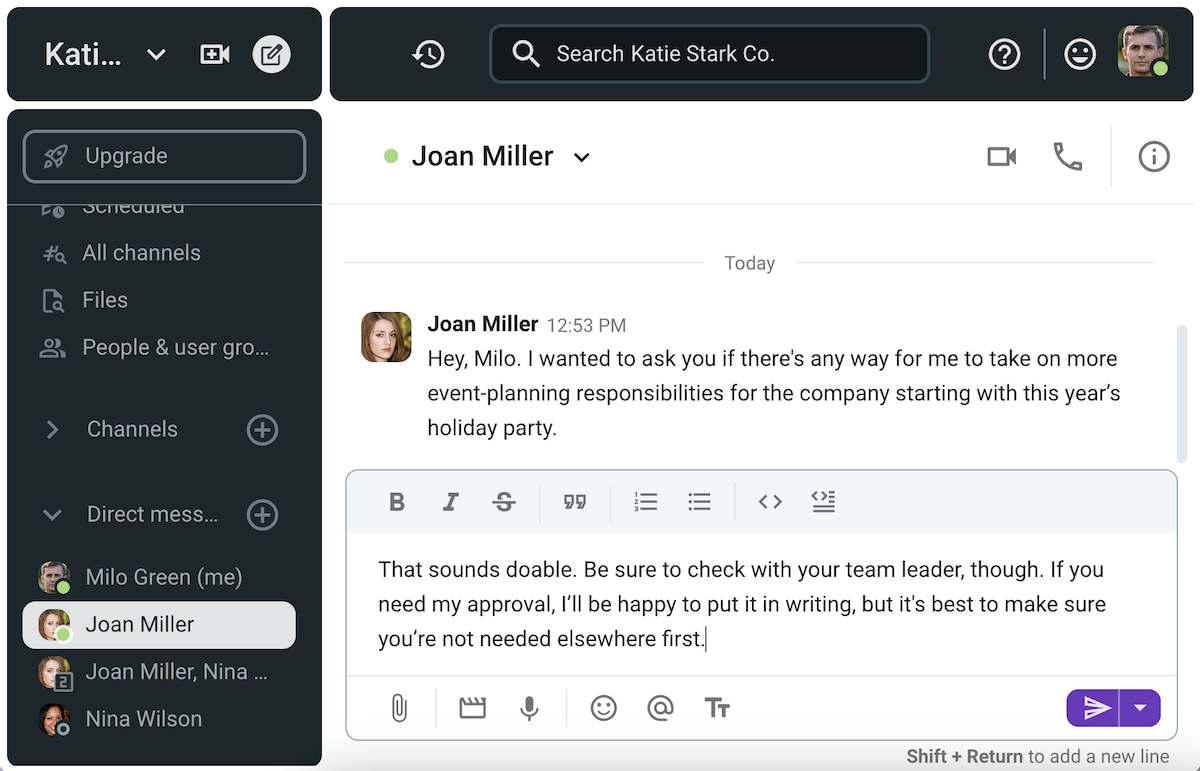
Check in with your coworkers on Pumble
Disadvantage #2: An open-door policy might end up being a mere formality
Leaving the door open for your employees doesn’t necessarily mean they will freely come to you at any time.
CEO of Legal-Island and co-author of the book Mastering Small Business Employee Engagement, Barry Phillips BEM understands this well.
In his TEDx Talk, he revealed his observations on why the open-door policy had failed him and other business leaders:
“I realized that they were using this open-door policy just as I was using it — as an excuse not to give any proper consideration to how communication should be done in an organization.”
He argues that there are many reasons why employees might not feel comfortable using the open-door policy, such as:
- Not feeling safe enough to speak,
- Coming from a culture that doesn’t encourage direct communication, or
- Being new to the company and feeling like they lack the authority to walk through the open door and talk to their manager.
Most often, it’s not enough to simply leave the door open. You need to understand how to help employees feel comfortable enough to come in.
In the case of the aforementioned reasons employees might have to stay silent when issues occur, business leaders should work on:
- Ensuring psychological safety in the workplace,
- Developing cultural intelligence, and
- Creating effective onboarding processes.
Disadvantage #3: Employees might become too dependent on managers
The opposite is also possible — employees might become too dependent on running every idea by their manager before making a decision.
This kind of employee-manager relationship is damaging for the entire team because everyone’s productivity plummets.
The superior becomes overwhelmed with employee requests, and the staff is unable to do anything without the manager’s approval.
Instead of having to field unnecessary questions, managers should teach employees how to find the answers independently, as shown in the following interaction.
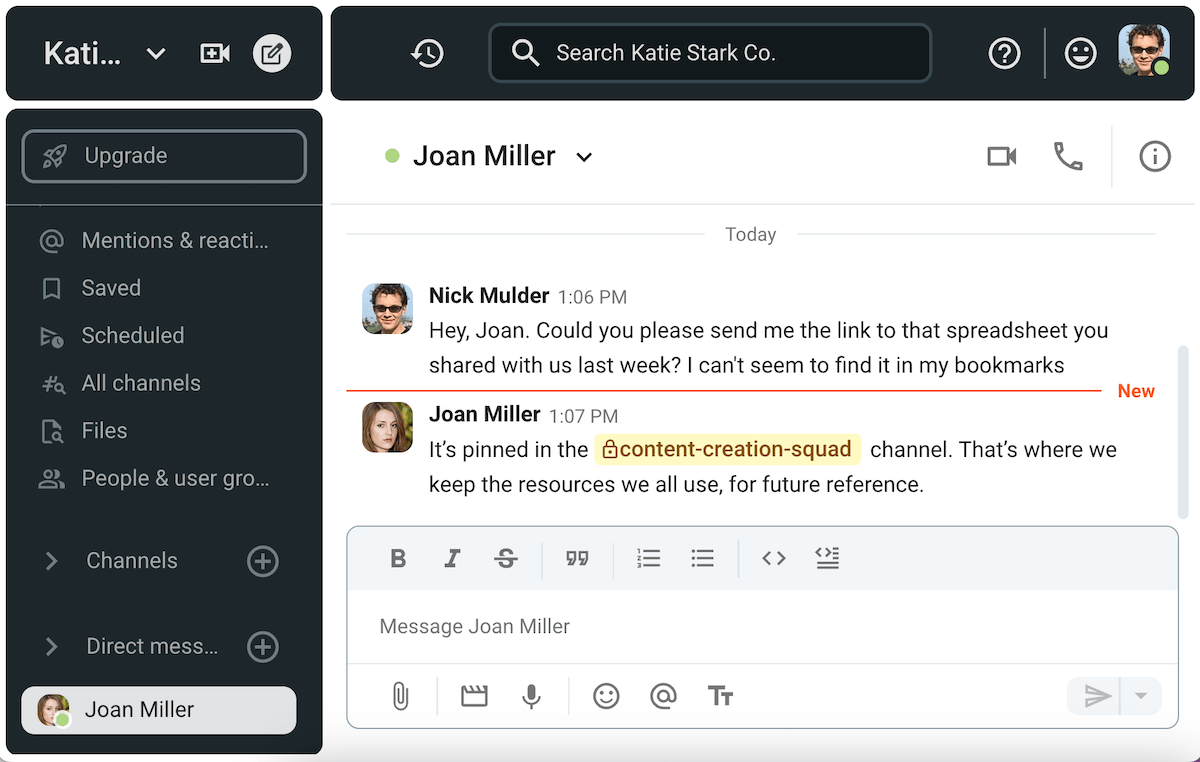
In any case, this shows us that an open-door policy can undermine employees’ sense of accountability, as they count on the superior to make all the decisions for them.
This dynamic can also fuel the practice of micromanagement and erode the culture of trust in the workplace.
Disadvantage #4: Managers may turn into confidants
Announcing “Feel free to approach me with any problem” is not a great way to set up an open-door policy.
Does it also mean an employee can complain to you about their baby keeping them up all night?
Or their romantic partner breaking up with them?
An unstructured open-door policy might prompt employees to infringe on managers’ work-life boundaries, as Jenna Rogers also pointed out:

“An open-door policy can sometimes convolute boundaries in the workplace, [which] threatens productive conversations.”
If you’re overeager to be there for your staff, without setting clear boundaries, you risk unintentionally becoming their therapist as well.
While there’s nothing wrong with engaging in occasional non-work-related talk with your team, there needs to be a balance between small talk and work communication.
How to create an open-door policy in the workplace
Now that we’ve established the pros and cons of having an open-door policy, we know that maintaining an open-door management style can be difficult.
Ultimately, its success depends on how you implement the policy.
If you want to get it right on your first try, you should:
- Make yourself more approachable,
- Get other decision-makers on board,
- Encourage upward communication,
- Set clear rules and boundaries,
- Communicate the policy to your employees,
- Create a safe work environment,
- Have a conflict management plan,
- Train managers on how to handle the policy,
- Listen attentively and respond promptly.
So, let’s delve into these tips for establishing an effective open-door policy and avoiding the most common pitfalls you might encounter on the way.
Tip #1: Make yourself more approachable
According to the findings of a research study titled Speaking truth to power, leaders often underestimate how difficult it can be for their staff to talk to them.
Neglecting to understand how risky it feels for employees to approach them can be all too easy.
But, there are ways to gain a deeper understanding of the issues at play here.
Namely, the authors of the aforementioned study advise leaders to ask themselves the following questions:
- Are you honestly interested in your team’s opinions?
- Have you assessed how risky it feels for employees to approach you?
- Are you aware of the political game your staff might play? (e.g. They might only say what you want to hear due to your position and status.)
- What status labels do employees apply to you and you to them? (e.g. “CEO”, “young”, “new”, etc.)
- What do you need to do to encourage others to speak freely?
On top of that, you can always try to see how you are perceived by your employees by asking them.
In the following screenshot of an interaction on Pumble, we can see how a manager might rely on the feedback of a team member he has a close relationship with.
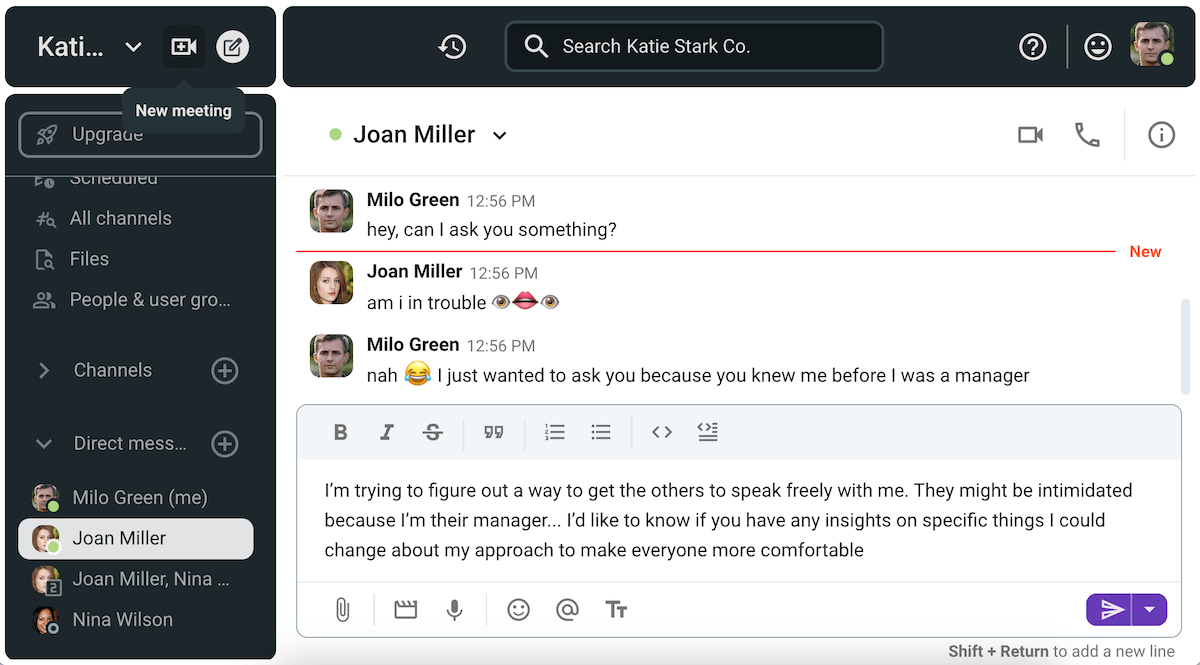
Highlight your availability with Pumble statuses
Engaging in this kind of introspection will help you understand your starting point better, which will, in turn, help you deliver a more effective pitch to other decision-makers.
Tip #2: Get other decision-makers on board
Chances are, no one will stop you from implementing an open-door policy that only applies to you.
However, if you want to have a greater impact on your company, you’ll have to get the other decision-makers on board with your plan.
In the words of Joseph Campagna, nothing can happen before HR gets the approval of upper management:

“[Getting the upper management’s participation] starts with allowing them to be part of the creation of the policy. Including them in the process:
1) Gives HR insight into what they actually think about the policy and how they perceive rank and file employees; and
2) Builds up their pride in the policy as creators and influencers.”
Echoing Campagna, Dr. Wilson also advised managers to consider the policies that may already be in place:

“Before instituting an open-door policy, consider gathering data from your HR department about any existing policies or processes that need to be considered. Inform the leadership team that you are considering this action and ask them to come up with reasons to support and/or any concerns that they may have. Gathering ideas, collaborating with the team, and addressing concerns before implementing the policy increases buy-in and support for the policy.”
On top of that, Jenna Rogers also notes that you can always bring in a communications consultant to cover all grounds:

“Working with a leadership or communications consultant to better understand how to implement boundaries and expectations can be a great first step when establishing an open-door culture in the workplace. This will allow leaders to understand:
- The goals of an open-door policy,
- Best practices for creating one, and
- How to make sure it is productive.”
Tip #3: Encourage upward communication
As Barry Phillips observed in his TEDx Talk, only active encouragement can prompt employees to speak up.
To learn more, we asked for his advice on stimulating upward communication.
He believes now is the right moment to make a change, as many businesses go remote:

“An open culture is the best means of encouraging upward communication, but this takes work, in particular meaningful training on how to give feedback as well as considerable thought in terms of how to facilitate meetings well. We have an opportunity now, however, as many meetings go online. We can rewrite the rules in terms of how to do meetings so much better than we ever did before.”
He further recommends creating “a dashboard of communication channels” together with employees, which would facilitate upward communication.
Some example channels Phillips lists include:
- Annual surveys,
- 360 appraisals,
- Stop Start Continue exercises (i.e. welcoming ideas on what to stop/start/continue doing in the future), and
- Team debriefs.
Joseph Campagna similarly emphasized the importance of regular feedback sessions and meetings:

“Follow policy with practice. Make sure managers are communicating proactively and seeking feedback. Ensure upper management is doing a semi-annual or quarterly all-hands meeting with real information on goals, sales, financial, etc.
Schedule and ensure that regular meetings happen with individual employees and their managers and with departments or other small groups. Revisit monthly or quarterly to keep up the practice.”
Managers can use feedback sessions to encourage upward communication, as showcased by the following announcement on Pumble.

Tip #4: Set clear rules and boundaries
The best way to approach establishing an open-door policy is to be systematic.
Simply announcing your openness to feedback is not enough, even if you’re extremely approachable.
Such a casual policy will leave the employees wondering the following:
- Is now the right time to approach you?
- Is their concern serious enough to involve you?
- Which superior should they take up the issue with?
These dilemmas and more might dissuade your staff from even trying to communicate.
That’s why it’s essential to cover all the details about how the policy should work.
If there are standard procedures and boundaries employees should follow to reach you, they are more likely to use them. They are also less likely to abuse the policy.
The rules of the open-door policy may include:
- The specific hours you’re available to employees,
- Instructions not to approach you when you change the status in your team chat app to “Unavailable,”
- An insistence on their taking the issue up with their immediate supervisor first and going up the executive ladder only if necessary,
- Specific communication channels for certain types of communication (e.g. a dedicated suggestion box for sharing project ideas),
- The types of problems not to approach you with (e.g. personal out-of-work issues), and
- Instructions on when your remote team members should DM you and when they should use a dedicated team messaging app channel.
These and other rules will ensure the policy works well, whether you’re running an office-bound or remote team.
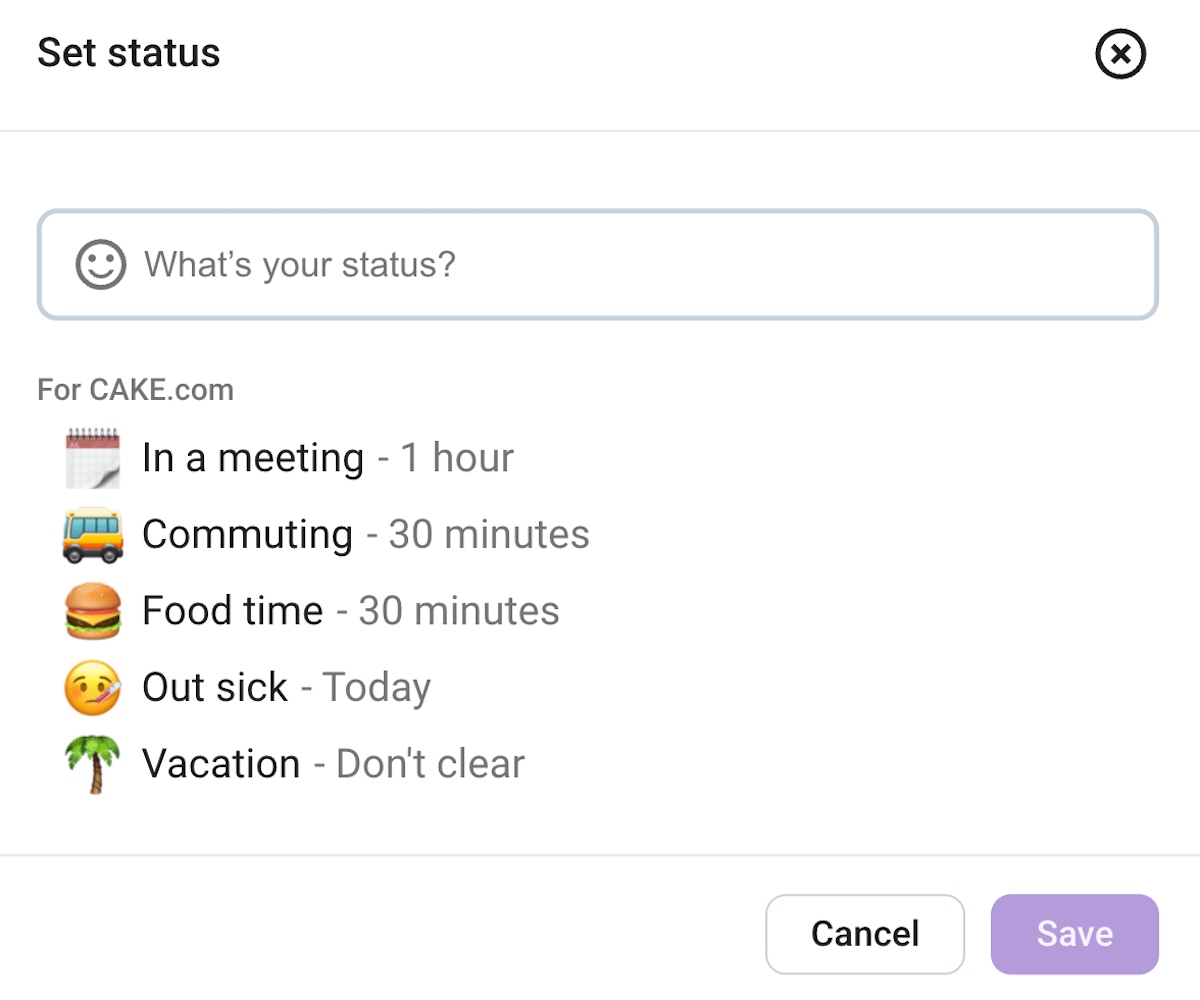
Tip #5: Communicate the policy to your employees
You may have already developed a highly detailed open-door policy and are wondering why it’s not working.
Well, it may be because you failed to communicate it clearly to your employees.
So, how can a boss consistently communicate an open-door policy?
One thing is certain: writing up a comprehensive policy and posting it on your company wiki page is not enough.
Joseph Campagna also said something to that effect:

“In my experience, management often loves to say they have an open-door policy, but it is usually because they sent a memo about it 10 years ago and put it in their handbook.”
The “set it and forget it” method doesn’t really work when it comes to encouraging open communication.
You need to keep reminding your employees of the ways they can approach you.
Since your staff probably doesn’t tend to visit your wiki every day, you can also share and pin the policy in your team chat app for easy access.
Aside from communicating your openness to hearing them out, you also need to set clear expectations with employees regarding the policy to avoid policy abuse or confusion.
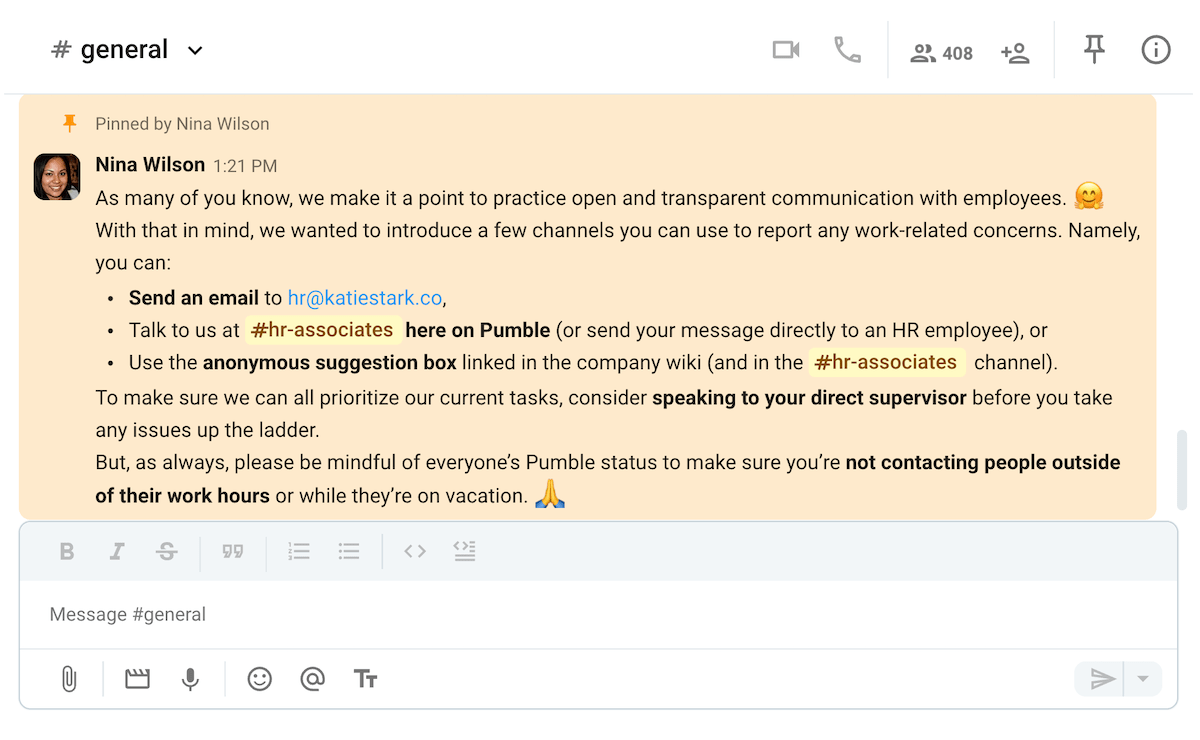
Share and pin important information in Pumble
Tip #6: Create a safe work environment
How many times a day do you get a “quick question” from your employees?
To be fair, their intention is not to take up much of your time.
But, if your staff keeps coming in all day long or your chat keeps pinging with quick questions, you end up doing nothing but answering these questions.
An environment where employees are too dependent on their managers is sometimes recognized as a “CYA (cover-your-ass) culture”.
In essence, it means employees avoid any accountability for their mistakes by making you the prime decision-maker in everything.
If this is the case with your team, you need to ask yourself why employees are afraid of making mistakes.
Do they fear severe consequences?
Are you impatient with their mistakes?
Create an environment where mistakes are seen as opportunities to learn and grow and empower your staff to make their own decisions.
As we have noted in our article on creating psychological safety in the workplace, this can be achieved by:
- Becoming more approachable by organizing more team and individual meetings and asking for your team members’ input before making certain decisions,
- Being patient and practicing respectful communication with your employees and coworkers, instead of becoming frustrated when issues occur,
- Setting an example for how your team members can deal with mistakes by taking accountability for your own,
- Focusing on finding solutions rather than harping on the consequences of mistakes,
- Making an effort to understand other perspectives, and
- Practicing gratitude and acknowledging those who make an effort to share their ideas or concerns.
The following image shows how a manager might deal with their mistake while acknowledging the team member who brought it to their attention.
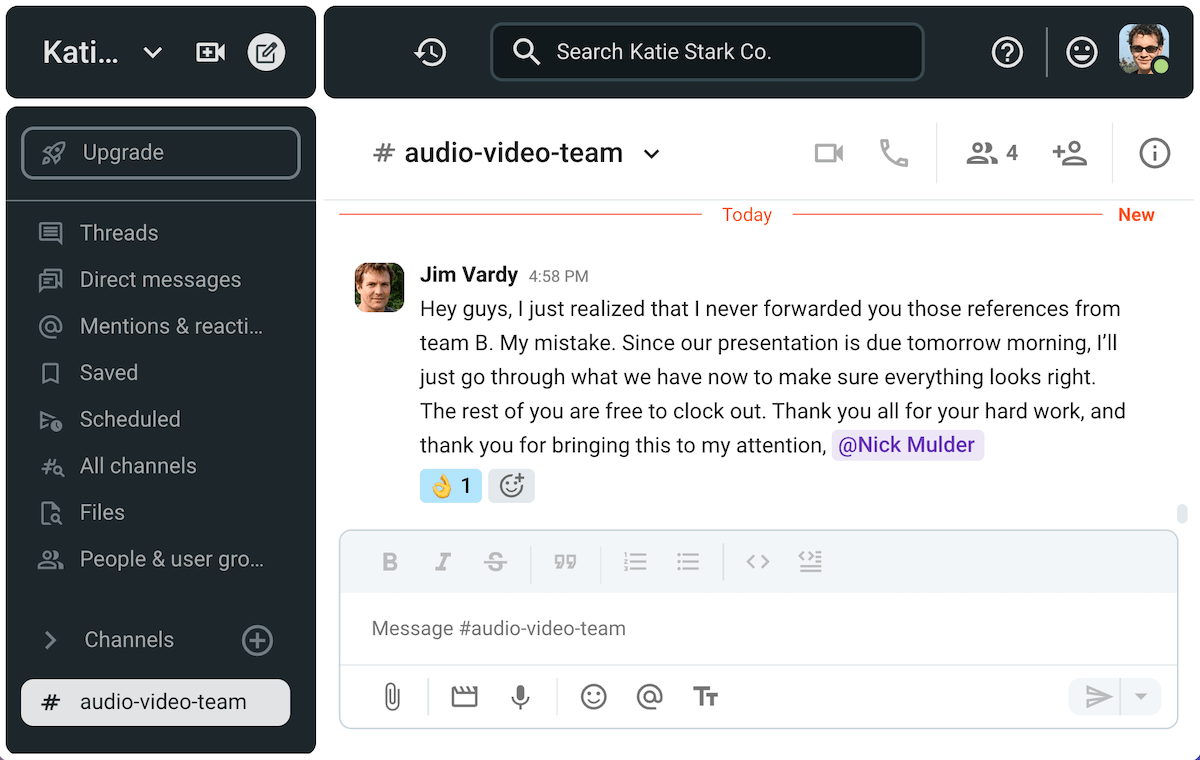
Tip #7: Have a conflict management plan
Ultimately, an open-door policy should encourage employees to go beyond happy talking points, as Joseph Campagna noted:

“Make sure the policy addresses:
1. How to make real complaints,
2. Process improvement,
3. Inventions and innovations,
4. Workplace conflict, and
5. Accountability.”
Therefore, understanding how to handle workplace conflict will benefit your open-door policy.
If an employee fails to reach common ground with their immediate manager, you may be called upon to act as an impartial mediator.
Knowing certain conflict resolution phrases and, indeed, getting conflict resolution training, will make these situations easier to deal with.
In most cases, interpersonal conflicts at work will be the result of a lack of effective communication.
So, if you learn to recognize and avoid miscommunication, you should be able to resolve almost any problem.
💡 PUMBLE PRO TIP
Teaching your employees how to disagree with each other respectfully will eliminate a large number of complaints you might receive. If you want your team to learn more about how to deal with disagreements at work, send them this article:
Tip #8: Train managers on how to handle the policy
Informing your employees about the open-door policy is only one part of its successful implementation.
If you’re an executive in an organization, you also need to enable all the managers to appropriately handle the policy.
Hold your training sessions on Pumble
Assuring employees that they can approach their supervisors with any issues or ideas will backfire disastrously if managers don’t cooperate. It will breed deep distrust and a sense of betrayal.
That’s why it’s important to train your managers on how to respond to any situation their subordinates approach them with.
Focusing on developing certain qualities and communication skills in your managerial staff is sure to set your open-door policy up for success.
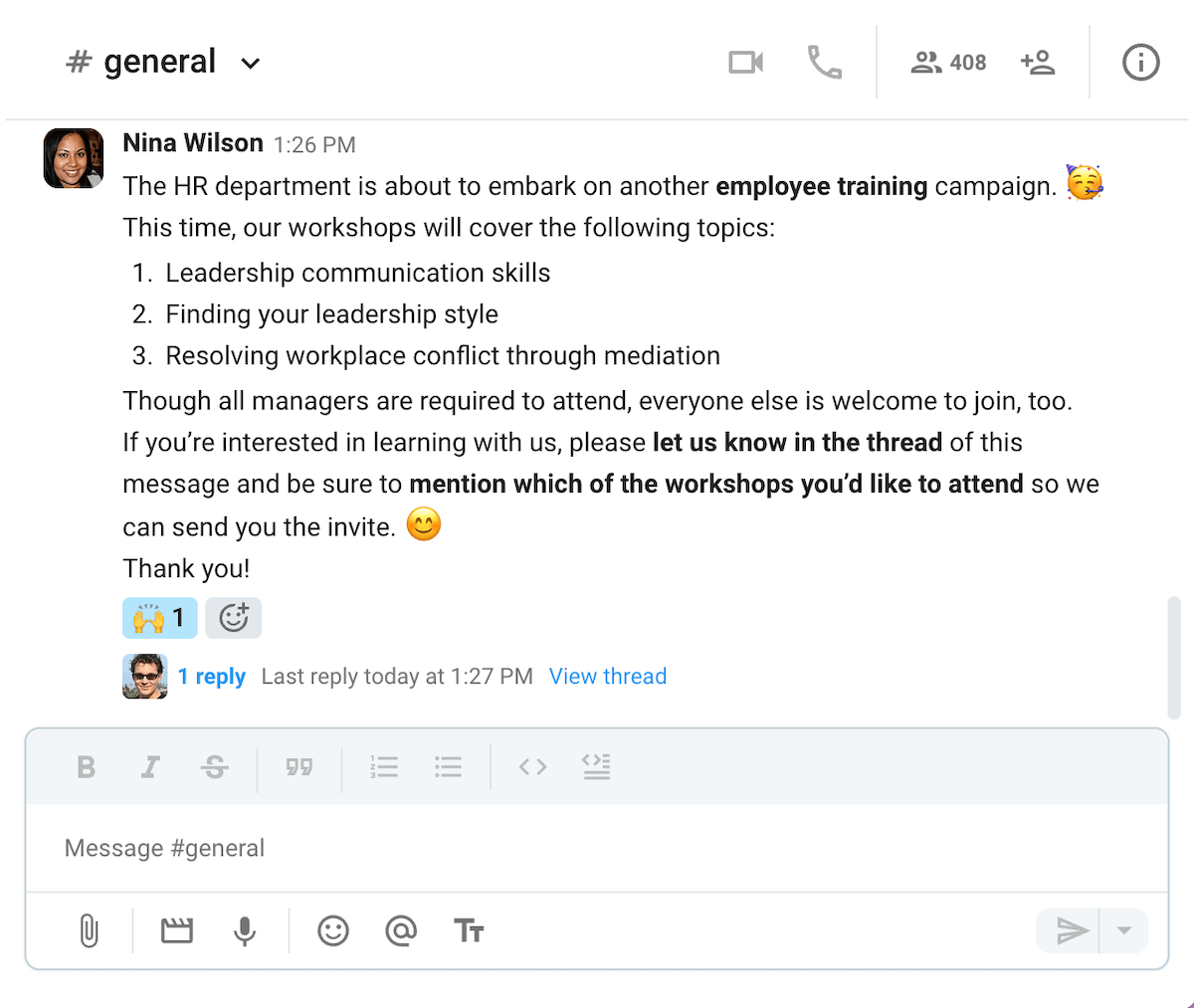
💡 PUMBLE PRO TIP
Get a head start on training your managers by sending them the following article:
Tip #9: Listen attentively and respond promptly
The art of active listening is one all leaders and managers need to master to truly experience all the benefits of an open-door policy.
What good is inviting people to speak up if you don’t show genuine interest in what they have to say?
A skilled listener pays attention not only to the content of what is being said, but also to the subtext, verbal, and nonverbal cues.
They take the time to reflect on what is being said and conveyed before they respond.
In essence, listening should be a major part of the leadership communication process.
💡 PUMBLE PRO TIP
To learn more about different leadership communication styles and get practical tips on how to develop one, visit our blog post on the subject:
Open-door policy workplace examples
Having discussed how to set up a successful open-door policy in the workplace, we’re now going to go over some examples of what this kind of communication strategy might look like from the perspectives of a CEO, a manager, and a regular employee.
Example #1: An open-door CEO
Most employees believe that the CEO of the company they work for has no time for them.
However, as Joseph Campagna noted, an open-door policy has to start from the top down.
That means that CEOs should also make themselves available to their employees.
One way to do that would be to emphasize that as CEO, one of your primary responsibilities is making sure that your employees have everything they need to do their jobs.
To do that, you can invite employees to reach out with any questions and concerns they might have.
Moreover, you can also offer up the link to your calendar and let everyone know that they can always schedule a meeting with you to discuss any ideas or work-related issues they might be having.
The following announcement on Pumble shows how a CEO who embraces an open-door policy might introduce himself to new employees.
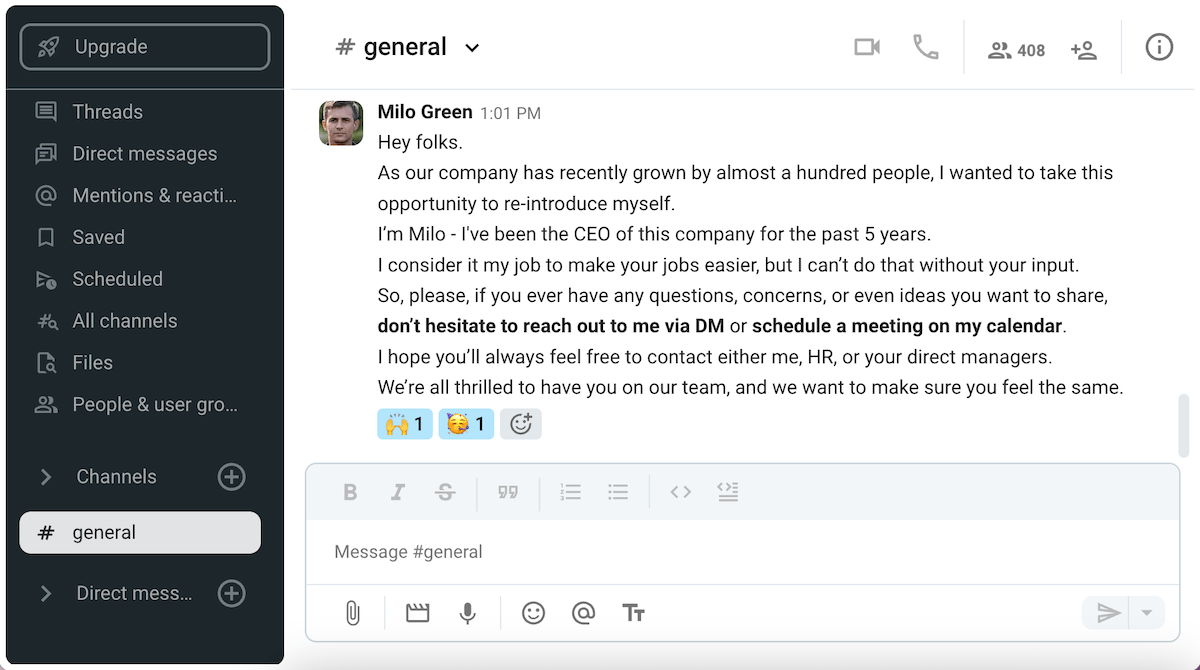
Example #2: An open-door manager
As some of the experts we have spoken to have pointed out, some managers take their open-door policy only as far as putting it in writing without adjusting their behavior to reflect the policy.
Simply saying that your door is always open won’t entice anyone to cross their threshold, even if they really need your help.
That’s why managers need to be proactive about keeping the conversation going within their teams through:
- Weekly meetings to discuss the team members’ progress with ongoing tasks,
- Occasional one-on-one meetings for individual check-ins, and
- Quarterly or annual feedback or, rather, feedforward sessions.
Hold your meetings over Pumble
Example #3: Open-door policy enables cross-team collaboration
Last but not least, we also wanted to point out that an open-door policy can influence lateral communication as well as interactions with other teams’ managers — otherwise known as diagonal communication.
To illustrate this, we’re going to imagine a copywriter working for a marketing company — Sabrina.
Sabrina has been handed the task of creating employer branding banners for a client.
After finishing the copy, she turned it over to the design team by making a task on Plaky, the project management software.
After some time, she was notified that the banners were complete. But, after checking the final result, she realized that her original copy contained a typo!
Luckily, this is nothing a brief chat with the designer can’t fix.
After checking the Plaky card to see who was assigned to the task, Sabrina sends the designer a direct message.
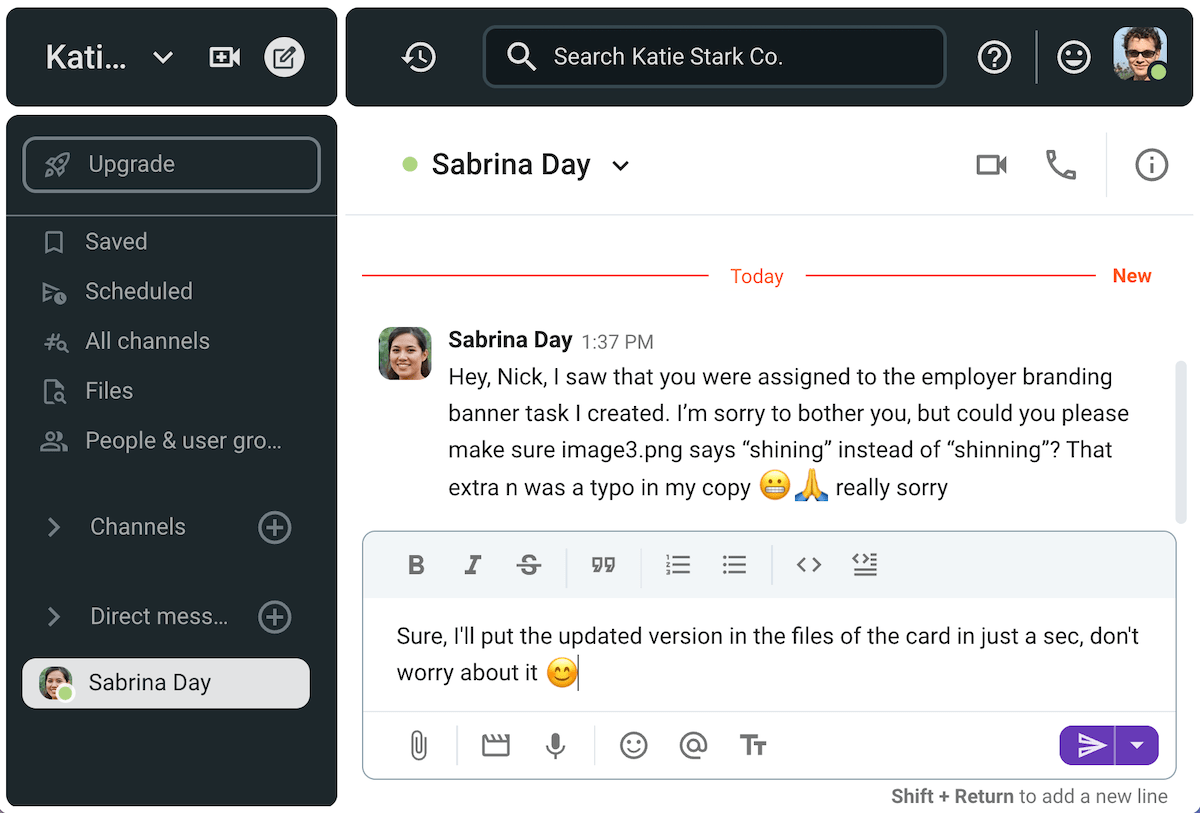
In a company with a closed-door policy, Sabrina might have had to contact her manager, who would then have to speak with the manager of the design team, before the request could make its way to Nick, the designer.
But, in an organization with an open-door policy, employees can contact each other freely, streamlining the collaborative process.
How to implement an open-door policy in the workplace with Pumble
As a team communication software, Pumble can accompany you on your quest to establish a successful open-door policy in your workplace.
It can be with you every step of the way, as you can use:
- The video conferencing feature during the initial planning phases and meetings between HR and executives,
- Dedicated channels to discuss certain topics (for example, employees who have computer problems can go right to the #IT channel to get help from the IT department),
- User profiles to set job titles and phone numbers, allowing everyone can reach out to anyone if they need to, and
- Predetermined or personalized statuses to let everyone know if you’re too busy to chat.
And that’s only the tip of the iceberg!
So, don’t just leave the door open — invite people in.









